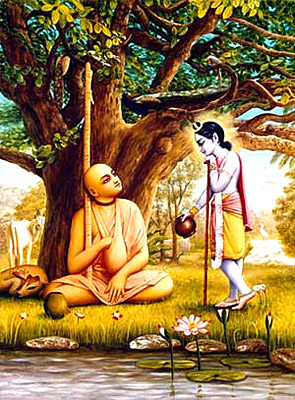 According to various sources he is a mendicant. Chaitanya Charitamrita is the major source of his personality. He also belongs to Madhva line as he was a disciple of Lakshmipati Tirtha. It also seems that Madhavendra was the founder of the Vaishnava centre at Mathura, Vrindavan. It is believed that he started the worship of the Gopala deity also known as Shrinathji. He has been credited with the discovery of the famous deity of Gopala near Govardhana that was worshiped by Vallabhacharya.
According to various sources he is a mendicant. Chaitanya Charitamrita is the major source of his personality. He also belongs to Madhva line as he was a disciple of Lakshmipati Tirtha. It also seems that Madhavendra was the founder of the Vaishnava centre at Mathura, Vrindavan. It is believed that he started the worship of the Gopala deity also known as Shrinathji. He has been credited with the discovery of the famous deity of Gopala near Govardhana that was worshiped by Vallabhacharya.
It is also believed that he received direct instructions and gifts from the deity of Gopinatha. This deity had ordered him to travel for the supply of scarce sandal wood paste from the Orissa to Malaya Mountains. Madhavendra Puri is often considered as the initiator of Chaitanya Mahaprabhu`s movement. Before Chaitanya it was he who preached the principles of Gaudiya Vaishnavism.
According to sources of Gaudiya Vaishnava he is believed to belong to Madhvacharya lineage that has been transcribed in the books like Gaura-ganoddesa-dipika and the writings of Gopala Guru Goswami. Advaita Acharya and Isvara Puri are believed to be the main disciples of Madhavendra Puri.
He died in Remuna, his memorial Samadhi and sandals are still worshiped there. For many Viashnava groups it is a place of pilgrimage.
Madhavendra Puri comes from the line of Sri Madhva, the acharya of the pure Dvaita or dualistic philosophy. His propaganda before meeting Sri Vyasa was limited to a destructive line of conquering mayavada. Under Vyasadeva he took up constructive side of regular preaching and made converts and commentaries as an authorized acharya. The preaching of the positive principle of other worldly dualism comes in the line of Sri Vyasa.
He is the connecting link between the Madhva and Gaudiya sampradayas. He is known to have introduced the conception of madhurya bhava in the Madhvacharya sampradaya. He sowed the seeds of prema bhakti.
This article is a stub. You can enrich by adding more information to it. Send your Write Up to content@indianetzone.com




















